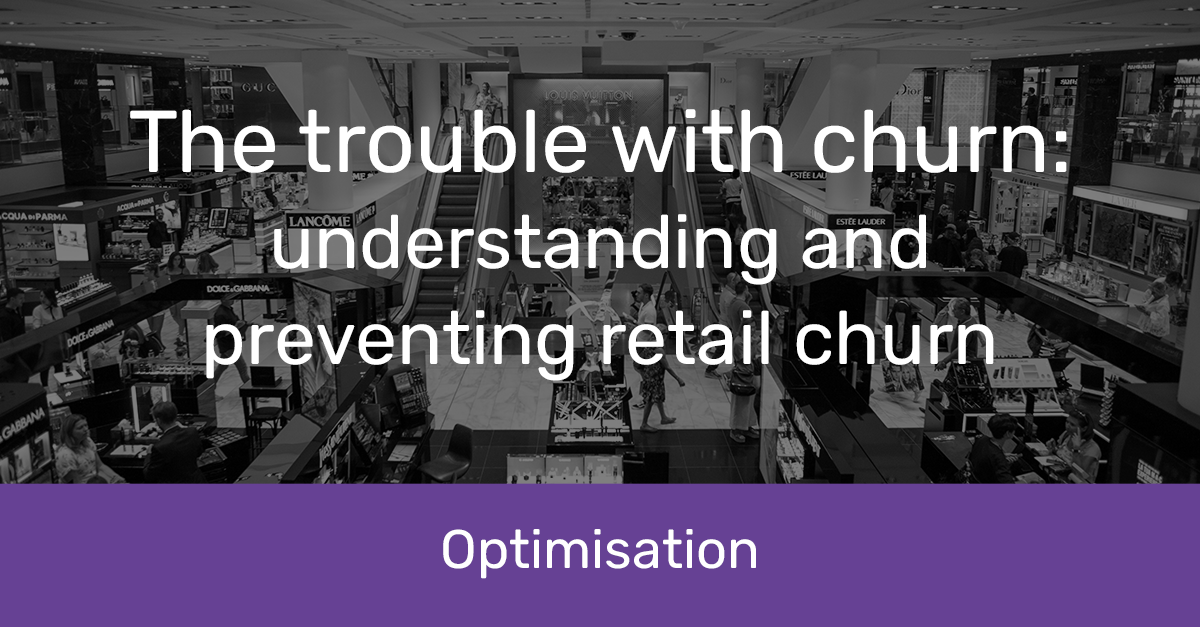The trouble with churn
Understanding and preventing retail churn
For retailers, churn is a dirty word. Customer churn is the process of customers leaving your business or no longer buying your product.
In service-based businesses, churn is reasonably easy to measure. In retail, it’s a bit less straightforward. Industries like finance, banking, telecommunications, insurance and SaaS have a clearly defined relationship – and a clear-cut endpoint.
In these industries, the customer journey looks like this:
- A customer signs a contract and agrees to receive ongoing services from the company for a set or indefinite period.
- At the end of the contract period – or earlier – the customer decides whether to continue or end their relationship with the company.
These companies can measure the rate of churn by tracking when customers leave and even asking them for feedback to understand why. In retail, it’s far more nebulous. That’s why it’s even more important to build an understanding of churn and work out why it’s happening.
The slow fade of retail churn
In retail, customers don’t tend to tell you they’re leaving unless they have a particularly bad experience with your product or customer service. Many retail customers don’t make a conscious decision to leave, they just drift away gradually.
That means retail churn presents as a slow slide out, rather than a swift chop. You’ll see a gradual decline in the level or frequency of sales, showing that customers are either spending less on your product or moving to your competitors.
Here’s what that might look like. Janet shops at your beauty supply store roughly once a month, spending around $40 per trip. After two years, her visits become less regular, averaging every 6-8 weeks. After several months, the amount she spends per trip also declines to $25-30. Although she can’t be counted as a churn statistic yet, her overall spend has decreased and she seems to be at risk of leaving altogether.
Identifying the early signs of a slide is a crucial part of your churn prevention strategy. Because retail data is extensive, messy and complicated, there’s no single stat that can identify churn beyond all doubt – it’s about looking at broader patterns.
Erratic buying patterns do not (always) equal churn
Retail buying is unique – and that can make it more difficult to decode the data and predict churn early on. Individual buying habits that can indicate an early slide into churn can also represent natural variation between customers. Some will shop on a regular schedule at one outlet, while others will shop occasionally and spread their spending among different retailers.
This complexity leads to confusion for retailers. In some cases, customers seen to be sliding may be targeted with intense marketing to keep them around – while other at-risk shoppers are ignored.
Although sliders are difficult to spot, they also offer a major advantage to retailers, as they’re much easier to pull back in than shoppers who have already left.
preventing potential churners early
As we’ve seen, the churn challenge is not just about collecting sales data – it’s about using smart analytics to identify at-risk sliders. A slider is our term for a customer who is highly likely to churn soon. If you can do that, you’ll be able to take action and pull some customers back from churning and taking their custom to the competition.
What does that look like in practice? It’s a form of analytics called Slider Modelling that helps retailers dig into the data and interpret the complex signals customers are sending through their behaviour.
This type of modelling uses past transaction data and customer profiles to identify patterns that lead to a slide – and churn. Then, that information is used to sift through your current transaction data, identifying customers who line up with those at-risk-of-churn patterns.
Done well, Slider Modelling is an efficient and accurate way to identify potential sliders and respond with appropriate marketing efforts and customer outreach. Drilling down even further, this type of model can be used to filter out low-value sliders, so you can gear marketing efforts toward higher-value customers.
Stop the slide towards churn
Once you’ve identified at-risk sliders, the analytics challenge is over and it’s time to pass the reins to your marketing team. They can reach out and try to stop the slide in different ways. Discount vouchers, loyalty benefits, free memberships, exclusive invites – it all depends on what your business does and how you reward your customers. There’s no way to stop every single customer from churning, but with the right techniques, you should be able to bring a good proportion of sliders back from the brink.
The Datamine team has done many churn prevention projects using analytical modelling and customer profiling. Recently, we worked with a large Kiwi retailer that wanted to retain loyalty programme customers and boost their spending. Our team used two years of data to build a conceptual model and give the business a framework to identify sliders. Its loyalty programme had around 300K members, and our analysis found that roughly 35K were sliding – and at risk of leaving altogether. With this data in hand, the business has been able to target these customers early in the sliding phase, before they pull away completely.
Decoding customer signals and reducing churn may be complex, but it’s far from impossible – you just need help from experts who have seen it all before.
Further Reading
Find out more about churn prevention, analytics and Slider Modelling in the Datamine Guide to Customer Retention.


















































